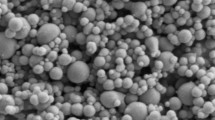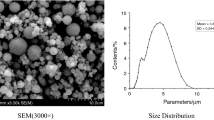Abstract
The ignition and combustion processes of concentrated nAl/JP-10 nanofluid fuel were studied by using a CO2 laser ignition system with online diagnosis, intermediate sampling, and offline analysis. The energy release properties of aluminum (Al) nanoparticles in droplets and the influence of oxygen content on agglomerate evolution were studied. The phase separation of liquid fuel and Al nanoparticles occurs during the combustion process of concentrated nAl/JP-10 nanofluid. The burning forms of Al nanoparticles within the droplet include local, splash out, and agglomerate burning. Among them, agglomerate burning is the primary form of energy release. During the combustion process, Al particles gradually form an Al agglomerate, and the oxidation reaction of Al nanoparticles mainly occurs after the diffusion flame disappears. Oxygen content has a significant effect on the agglomerate burning of Al nanoparticles. When oxygen content is > 10%, the Al particles are successfully ignited. When oxygen content reaches 50%, a deflagration of the agglomerate occurs, and the Al particles rapidly oxidize to completely release heat and form a dense alumina sphere.











Similar content being viewed by others
References
Glotov OG, Yagodnikov DA, Vorob’Ev VS, Zarko VE, Simonenko VN. Ignition, combustion, and agglomeration of encapsulated aluminum particles in a composite solid propellant II Experimental studies of agglomeration. Combust Explos Shock. 2007;43(3):320–33.
Brooks KP, Beckstead MW. Dynamics of aluminum combustion. J Propuls Power. 2012;11(4):769–80.
Ao W, Liu X, Rezaiguia H, Liu H, Wang Z, Liu P. Aluminum agglomeration involving the second mergence of agglomerates on the solid propellants burning surface: experiments and modeling. Acta Astronaut. 2017;136:219–29.
Kumar AS, Rao VB, et al. Evaluation of plastic bonded explosive (PBX) formulations based on RDX, aluminum, and HTPB for underwater applications. Propellants Explos Pyrotech. 2010;35(4):359–64.
Feng Y, Xia Z, Huang L, Yan X. Experimental investigation on the combustion characteristics of aluminum in air. Acta Astronaut. 2016;129:1–7.
Sundaram DS, Puri P, Yang V. A general theory of ignition and combustion of nano- and micron-sized aluminum particles. Combust Flame. 2016;169:94–109.
Xin LI, Zhao FQ, Hao HX, Yang L, Si-Yu XU, Yao EG, et al. Research on ignition and combustion properties of different micro/nano-aluminum powders. Acta Armamentarii. 2014;35(5):640–7.
Mench MM, Kuo KK, Yeh CL, Lu YC. Comparison of thermal behavior of regular and ultra-fine aluminum powders (alex) made from plasma explosion process. Combust Sci Technol. 1998;135(1–6):269–92.
Tepper F, Kaledin L. Combustion characteristics of kerosene containing Alex® nano-aluminum. Int J Energ Mater Chem Propuls. 2002;5(1–6):195–205.
Dong MK, Baek SW, Yoon J. Ignition characteristics of kerosene droplets with the addition of aluminum nanoparticles at elevated temperature and pressure. Combust Flame. 2016;173:106–13.
AIAA, editor. Ignition of a liquid hydrocarbon containing nano-sized aluminum using an aerosol shock tube. AIAA Aerospace Sciences Meeting Including the New Horizons Forum and Aerospace Exposition; 2013.
Tyagi H, Phelan PE, Prasher R, Peck R, Lee T, Pacheco JR, et al. Increased hot-plate ignition probability for nanoparticle-laden diesel fuel. Nano Lett. 2008;8(5):1410–6.
Xiutianfeng E, Pan L, Wang F, Wang L, Zhang X, Zou JJ. Al-nanoparticle-containing nanofluid fuel: synthesis, stability, properties, and propulsion performance. Ind Eng Chem Res. 2016;55(10):2738–45.
Gan Y, Li Q. Combustion characteristics of fuel droplets with addition of nano and micron-sized aluminum particles. Combust Flame. 2011;158(2):354–68.
Gan Y, Yi SL, Li Q. Combustion of nanofluid fuels with the addition of boron and iron particles at dilute and dense concentrations. Combust Flame. 2012;159(4):1732–40.
Gan Y, Qiao L. Evaporation characteristics of fuel droplets with the addition of nanoparticles under natural and forced convections. Int J Heat Mass Trans. 2011;54(23):4913–22.
Javed I, Baek SW, Waheed K. Evaporation characteristics of heptane droplets with the addition of aluminum nanoparticles at elevated temperatures. Combust Flame. 2013;160(1):170–83.
Miglani A, Basu S. Effect of particle concentration on shape deformation and secondary atomization characteristics of a burning nanotitania dispersion droplet. J Heat Trans. 2015;137(10):102001.
Zhu Y, Yuasa S. Effects of oxygen concentration on combustion of aluminum in oxygen/nitrogen mixture streams. Combust Flame. 1998;115(3):327–34.
Sun Y, Sun R, Zhu B, Wu Y, Wang Q, Han W. Combustion characteristics of nanoaluminum cloud in different atmospheres. Ind Eng Chem Res. 2017;57(1):129–38.
Acknowledgements
This work was supported by the National Natural Science Foundation of China (Grant No. 51876187).
Author information
Authors and Affiliations
Corresponding author
Additional information
Publisher's Note
Springer Nature remains neutral with regard to jurisdictional claims in published maps and institutional affiliations.
Rights and permissions
About this article
Cite this article
Liu, J.Z., Chen, B.H., Wu, T.T. et al. Ignition and combustion characteristics and agglomerate evolution mechanism of aluminum in nAl/JP-10 nanofluid fuel. J Therm Anal Calorim 137, 1369–1379 (2019). https://doi.org/10.1007/s10973-019-08039-5
Received:
Accepted:
Published:
Issue Date:
DOI: https://doi.org/10.1007/s10973-019-08039-5




